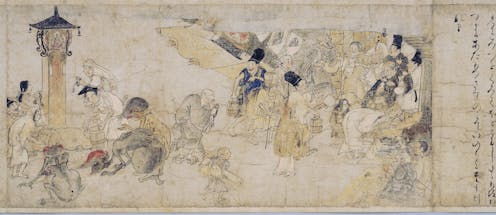
A scroll illustrating the realm of the hungry ghosts, one of the six realms in Buddhist cosmology. Kyoto National Museum via Wikimedia Commons
Uncommon Courses is an occasional series from The Conversation U.S. highlighting unconventional approaches to teaching.
Title of the course
Ghosts, Zombies and Monsters: What We Fear and Loathe in Religions
What prompted the idea for the course?
I am an expert in Tibetan Buddhism, women and gender, but not in ghosts, zombies and monsters. However, my experience teaching introductory courses on Asian religions and religious studies prompted me to grapple with the challenge of teaching students the importance of understanding the people whom we feel are “other” and come to terms with things that do not make sense.
These fearsome, “other-than-human” beings live on the boundaries of our moral, social and emotional imagination, and they often embody the issues, concerns, hopes and fears that have shaped our lives. Therefore, they are the ideal pedagogical candidates to challenge one’s preconceived notions of death, self and the other.
What does the course explore?
The course is divided into three thematic sections. First, we reflect on ghosts, examining how different cultures provide specific definitions of death and imaginations of an afterlife. We read about Buddhist hungry ghosts, or “pretas,” and Chinese ghost stories. We also explore discussions of hauntings in a Thailand airport as well as the experience of ghost hunters in North America. Ghosts are often believed to be beings who failed to transition to an ideal afterlife and linger in a liminal state, interacting with and haunting the living.
Second, we examine zombies. These are considered another type of liminal beings who are regarded to be alive but have lost the distinct stories that make each of them a unique individual, according to scholar of monster theory Jeffrey Jerome Cohen. We explore the Haitian origin of zombies and the phenomenon of the “uncanny valley,” the eerie feeling we may experience when encountering something that appears almost human but not quite.
Last, we look at monsters. Monster theories and the study of monstrous beings as a cultural category have grown into a flourishing field of inquiry in recent decades. This has opened many avenues for exploring beings typically regarded as categorically different from humans.
The class explores monsters as disastrous animals, gendered beings, exiles from their religious communities and names evoked in news reports to describe individuals who have committed particularly disturbing crimes. We ask questions such as why some animals are more likely to be seen as frightening or malicious than others, and what is gained and lost by calling someone a “monster.”
Why is this course relevant now?
Ghosts, zombies and monsters are as ancient and as contemporary as the humans living with them. We will probably never stop fearing, being disgusted by or projecting some people among us as “monsters.” However, at a time when fear, disgust and labeling carry unusual weight in shaping relationships in our own community, I believe critically reflecting on how we engage with difference and otherness is an urgent call. Monstrous and demonic beings also ultimately occupy a place where boundaries are constantly pushed and redrawn. What was monstrous once might be no longer now, and vice versa.
What’s a critical lesson from the course?
This course brings to the fore what is commonly demonized, marginalized or unseen in religious traditions across the globe, and it asks what it is about ghosts, zombies and monsters that appalls and arrests us. One lesson students take away from the course is that our fears and horrors are always culturally and contextually specific. In other words, ghosts, zombies and monsters are also reflections of ourselves.
What materials does the course feature?
We watch three films, one for each section: Masaki Kobayashi’s “Kwaidan,” Jordan Peele’s “Get out” and Penny Lane’s “Hail Satan?”
Students also become familiar with a variety of narratives – both serious and humorous – about ghosts, zombies and monsters, ranging from “Strange Tales from a Chinese Studio,” a collection of supernatural stories, to Key & Peele sketches about Satan or the zombie apocalypse, and Haruki Murakami’s short story “Super-Frog Saves Tokyo.”
Key & Peele.
What will the course prepare students to do?
Good storytelling plays a crucial role, as it allows us to temporarily inhabit another, imagined world. Many of my students revealed their talent for storytelling during a class session where we went around the room sharing spooky tales. In the act of telling each other stories, we begin to understand and navigate our differences.
Students are not going to become professional demon tamers or ghost hunters after this class. Instead, I hope they leave with a newly found recognition, if not tenderness, toward creatures and things they originally were afraid of or felt repulsed by.
The author would like to acknowledge the Baker-Nord Center for the Humanities at Case Western Reserve University for providing a Flash Grant in support of pedagogical research for this course on ghosts, zombies, and monsters.
Advertisement

Advertisement
Contact Us
If you would like to place dofollow backlinks in our website or paid content reach out to info@qhubonews.com









